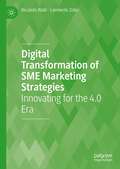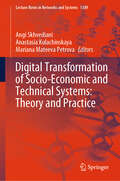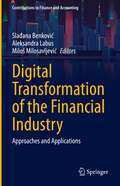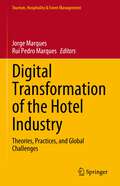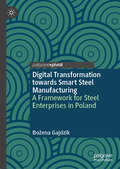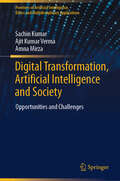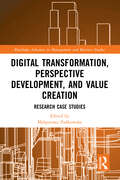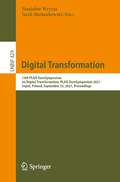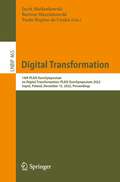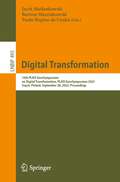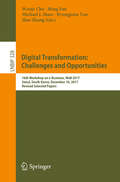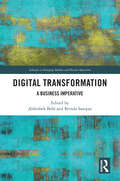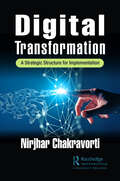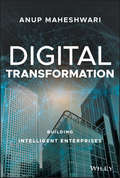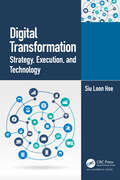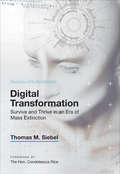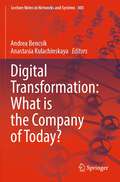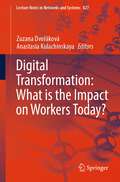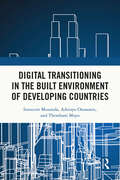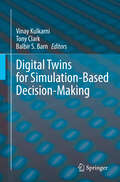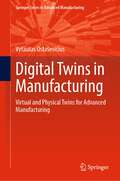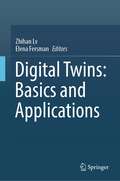- Table View
- List View
Digital Transformation of SME Marketing Strategies: Innovating for the 4.0 Era
by Riccardo Rialti Lamberto ZolloSMEs represent more than 95% of businesses operating in global markets. These businesses are the fabric of any economic system both in developed and emerging countries, and are the main constituents of any global supply chain throughout the world. However, research on new 4.0 marketing strategies for this kind of businesses has been largely neglected. Extant literature mostly neglects, or fails to articulate the importance of emerging technology such as Big Data, Artificial Intelligence and VR/AR for SMEs. Building on that, this book reviews existing literature on innovation and new technology in marketing for SMEs, what they could do and should avoid. Then, presenting multiple case study from SMEs operating in diverse industries (fashion and design, food and wine, financial services), it develops a practical strategic framework that could be used by SMEs wishing to effectively innovate their marketing strategies in our contemporary digital era. It will be an essential resource for students and researchers of marketing, innovation and industry 4.0.
Digital Transformation of Socio-Economic and Technical Systems: Theory and Practice (Lecture Notes in Networks and Systems #1309)
by Angi Skhvediani Mariana Mateeva Petrova Anastasia KulachinskayaIn the theoretical field, this book presents innovative concepts and models that elucidate the dynamics and implications of digitalization across diverse socio-economic systems. Additionally, from a practical perspective, the book offers real-world examples and case studies that illustrate successful strategies for implementing digital technologies and their contributions to the sustainable development of various industries. In recent years, digital economy has become a key driver, which fosters growth of various systems. The COVID-19 pandemic has additionally boosted this process and resulted in higher effectiveness of both formal and informal institutes, structural changes on labour market, new opportunities for social mobility, new markets, new forms of interaction between government, individuals, and enterprises. On the other hand, these processes entailed significant challenges among which are digital divide, cyber security, high costs of process digitalization, etc. This book is designed for researchers, educators, students, and practitioners interested in acquiring profound insights into the contemporary processes of digital transformation and their impact on socio-economic and technical systems.
Digital Transformation of the Financial Industry: Approaches and Applications (Contributions to Finance and Accounting)
by Slađana Benković Aleksandra Labus Miloš MilosavljevićThis book presents a collection of state-of-the-art research findings on the digital transformation of financial services. Digitalization has fundamentally changed financial services and has a tendency to reshape the landscape of the financial industry in an unprecedented manner. Over the last ten years, the development of new financial technologies has contributed to the creation of new business and organizational models, along with new approaches to service delivery. By encompassing significant conceptual contributions, innovations in methods and techniques, and by delineating the main applications of digital transformation in Central and Eastern Europe (CEE), the volume extends current knowledge on digital transformation in the financial industry. The book is divided into two parts. The first part provides a social-science perspective on digital transformation in the financial industry. The second part provides the most recent evidence on how financial technologies are transforming financial services on the markets, and how the adoption of modern information technologies fosters setting up new financial services. Further, this part outlines new approaches to digital transformation in the financial industry.This book will appeal to students, scholars, and researchers of finance, monetary economics, and business, as well as practitioners interested in a better understanding of the digital transformation of financial services, new financial technologies, and innovations in finance.
Digital Transformation of the Hotel Industry: Theories, Practices, and Global Challenges (Tourism, Hospitality & Event Management)
by Rui Pedro Marques Jorge MarquesThe hotel industry has gone through important transformations, not only in terms of management and operation but also in terms of interaction with consumers. Technological development and adaptation to the digital era have been one of the greatest challenges for hotels. This book aims to fill the gap in the literature in this specific area of the tourism sector and contribute to a better understanding of trends and challenges in the hotel industry on a global scale.
Digital Transformation towards Smart Steel Manufacturing: A Framework for Steel Enterprises in Poland
by Bożena GajdzikThis book presents the impact of digital transformation and other megatrends on the steel industry, focusing on the digitization of processes, and the automation and robotization of operations in steel companies. Technological innovations in the steel industry are presented, as well as the changes taking place within the supply chains An essential part of the book is the results of direct research, which deal with the transformation of enterprises to smart steel manufacturing. The research was done on the Polish steel market, which is an open market with foreign capital. Exploring a sample of representatives of steel companies that serve both domestic and foreign markets, this book discusses the implementation of the pillars of Industry 4.0 as well as the strategic transformation of the steel industry.
Digital Transformation, Artificial Intelligence and Society: Opportunities and Challenges (Frontiers of Artificial Intelligence, Ethics and Multidisciplinary Applications)
by Ajit Kumar Verma Sachin Kumar Amna MirzaThis book examines the fundamental concepts and principles of digital transformation and AI, including their historical development, and underlying technologies, and analyzes the opportunities arising from digital transformation and AI in different sectors, such as healthcare, finance, education, transportation, and governance. It provides a comprehensive overview of digital transformation and AI technologies and their current state of implementation. It also explores the potential challenges and risks associated with digital transformation and AI, including ethical considerations, job displacement, privacy concerns, biases, impact on inequality, social interactions, and the overall well-being of individuals and communities. Additionally, the books provides and discusses policy and regulatory frameworks that can effectively address the opportunities and challenges posed by digital transformation and AI leading to responsible AI. It also delves into impact of automation on the job market and workforce. The book concludes by proposing potential strategies for navigating opportunities and challenges of digital transformation and AI integration. It emphasizes the need for interdisciplinary collaboration among stakeholders, including policymakers, industry leaders, academia, and civil society, to develop a comprehensive approach towards harnessing the full potential of digital transformation and AI and associated technologies. The book employs a multidisciplinary approach, drawing from various fields such as computer science, sociology, philosophy, political science, economics, law and governance. It combines theoretical analysis, empirical case studies, and expert perspectives to provide a holistic view of the subject matter. This book caters to a diverse audience, including students, researchers, academics, policymakers, industry professionals, and technology enthusiasts. It provides a valuable resource for those seeking a comprehensive understanding ofthe opportunities and challenges arising from the integration of digital transformation and AI in society.
Digital Transformation, Perspective Development, and Value Creation: Research Case Studies (Routledge Advances in Management and Business Studies)
by Małgorzata PańkowskaThis edited collection aims to provide relevant theoretical frameworks and the latest empirical research findings in the area of business management. It covers case studies provided by teachers visiting the University of Economics in Katowice, Poland, within Erasmus and CEEPUS Programmes. Over 12 years, approximately 25 teachers have been coming year by year to Katowice, presenting their monographic lectures and participating in seminars on their research results and educational achievements. This book contains descriptions of case studies, elaborated by Erasmus and CEEPUS teachers, illustrating that the case study is a method of research as well as a method applied in education and emphasizing the value of qualitative methods by example of case studies. The key benefit of qualitative research is that it allows a researcher to perceive and understand context within which decisions and actions take place. Hence, to understand peoples’ motivations, their reasons, their actions, and the context for their beliefs and actions, qualitative research is the best route. Assuming that business organizations as well as individuals are entirely linked together via the Internet, a new approach to business communication and marketing, business modelling and management are developed to reveal an increase of business synergy effects, the alignment of information and communication technologies (ICT) and business and social value creation, as well as sustainability and environment protection. Through this book, readers have an opportunity to learn about relevance and rigor in qualitative research and how the case study can be applied in various organizational contexts.
Digital Transformation: 13th PLAIS EuroSymposium on Digital Transformation, PLAIS EuroSymposium 2021, Sopot, Poland, September 23, 2021, Proceedings (Lecture Notes in Business Information Processing #429)
by Stanisław Wrycza Jacek MaślankowskiThis book constitutes the refereed proceedings of the 13th PLAIS EuroSymposium 2021 which was held in Sopot, Poland, on September 23, 2021. The objective of the PLAIS EuroSymposium 2021 is to promote and develop high quality research on all issues related to digital transformation. It provides a forum for IS researchers and practitioners in Europe and beyond to interact, collaborate, and develop this field. The 10 papers presented in this volume were carefully reviewed and selected from 34 submissions. They were organized in topical sections named: digital enterprises; smart cities; digital education; and innovative methods in data and process analysis.
Digital Transformation: 14th PLAIS EuroSymposium on Digital Transformation, PLAIS EuroSymposium 2022, Sopot, Poland, December 15, 2022, Proceedings (Lecture Notes in Business Information Processing #465)
by Paulo Rupino da Cunha Jacek Maślankowski Bartosz MarcinkowskiThis book constitutes the refereed proceedings of the 14th PLAIS EuroSymposium 2022 which was held in Sopot, Poland, on December 15, 2022. The objective of the PLAIS EuroSymposium is to promote and develop high quality research on all issues related to digital transformation. It provides a forum for IS researchers and practitioners in Europe and beyond to interact, collaborate, and develop this field. The leading topic for the EuroSymposium this year was “Digital Transformation”. The 8 papers presented in this volume were carefully reviewed and selected from 23 submissions. They were organized in topical sections named: artificial intelligence; creativity and innovations; big data, internet of things and blockchain technologies.
Digital Transformation: 15th PLAIS EuroSymposium on Digital Transformation, PLAIS EuroSymposium 2023, Sopot, Poland, September 28, 2023, Proceedings (Lecture Notes in Business Information Processing #495)
by Paulo Rupino da Cunha Jacek Maślankowski Bartosz MarcinkowskiThis book constitutes the proceedings of the 15th PLAIS EuroSymposium on Digital Transformation, PLAIS EuroSymposium 2023, which took place in Sopot, Poland, in September 2023. The primary objective of the PLAIS EuroSymposium 2023 was to foster discussions on general issues pertaining to digital transformation and related topics. The papers selected this year are related to the use of machine learning, internet of things and social media. The 7 full papers included in this volume were carefully reviewed and selected from a total of 22 submissions.
Digital Transformation: 16th Workshop On E-business, Web 2017, Seoul, South Korea, December 10, 2017, Revised Selected Papers (Lecture Notes in Business Information Processing #328)
by Han Zhang Michael J. Shaw Ming Fan Wooje Cho Byungjoon YooThis book constitutes revised selected papers from the 16th Workshop on e-Business, WeB 2017, which took place in Seoul, South Korea, in December 2017. The purpose of WeB is to provide an open forum for e-Business researchers and practitioners world-wide, to share topical research findings, explore novel ideas, discuss success stories and lessons learned, map out major challenges, and collectively chart future directions for e-Business. The WeB 2017 theme was “Digital transformation: challenges and opportunities”. The 11 papers presented in this volume were carefully reviewed and selected from 43 submissions. These are original research articles with a broad coverage of behavioral issues on consumers, citizens, businesses, industries and governments, ranging from technical to strategic issues.
Digital Transformation: A Business Imperative (Advances in Emerging Markets and Business Operations)
by Edited by Abhishek Behl and Brinda SampatDigitization, with the help of artificial intelligence, machine learning, social media, and cloud adoption, has significantly transformed industries and helped companies accelerate, grow, and have a competitive edge. This book discusses how digital transformation can help organizations achieve growth and explores the challenges of using emerging technologies.Digital disruption has a significant effect on how businesses operate. Organizations must follow a strategic approach while on the path to digital transformation as their technology and operational decisions must be aligned. This volume provides a roadmap for businesses to adopt digital solutions and systems in all aspects of a company’s functioning. With case-based examples, the book demonstrates how organizations globally use digital technologies to enhance their business operations; examines strategies that work and those that do not; highlights lessons organizations can learn from the success and failures of digitization; and looks at the perils of using such technology, which can often also endanger the organization's functioning and raise consumer privacy concerns.Part of the Advances in Emerging Markets and Business Operations series, this volume includes examples and best practices from companies that provide a framework for designing a digital strategy. It will be useful for students and researchers of business studies, management studies, human resources, organization studies, IT management, and information and communication. It will also be of interest to organizations and managers.
Digital Transformation: A Strategic Structure for Implementation
by Nirjhar ChakravortiWith the advent of digital technologies, society is reshaping itself radically. In the last decade, digital technologies have brought fundamental changes in the industry and business environment. The holistic socioeconomic and industrial changes are a result of general-purpose technology aspects of digital transformation, which are rare and have inherent capabilities of self-transformation to bring long-term benefits across the entire global business environment. After the steam engine, electric generator and printing press, the recent development of digital transformation has created an opportunity with extensive sustainable and incremental influence for disruption and renovation. However, the most important difference between digital transformation and the previous general-purpose technologies such as steam engines and electric generators is the pace of technology’s penetration across the globe. To cope with the accelerated speed of global digitization, the digital transformation process should be accepted, adopted and adapted across society and business utilizing a multi-dimensional strategy. This book illustrates a strategic structure that covers Digital Challenges for Industries, Applicability for Digital Transformation, Digital Transformation Framework, People and Organization Structure, Capability Delivery Activities and Life Cycle Benefits. How will businesses embrace digital transformation? How will organizations formulate a digital transformation strategy? How will they invest in digital technologies? To answer these questions, a strategic structure is created which can provide guidelines to businesses to create a framework for digital transformation that includes strategy, process, governance and funding. The exponential growth in data capacity (storage, process and communication) due to rapid digitalization has created infinite opportunities and different dimensions to businesses. Digital platforms have enabled alternative business models by deconstructing the traditional value chains. Agile concepts driven by design thinking have brought innovative perspectives with an environment of boundless disruption. To run a company with sustainability and manage disruptions more consciously, the adoption of a digital platform with an appropriate strategy is the only viable option. Digital transformation (DX) goals and strategies should be in line with a company’s business objectives. The strategic structure explained in the book is a global framework that can be adopted by any profit or nonprofit organization. Like any other transformational process, digital transformation has created structural tension between "old" and "new". In this tension, employees play a large role and their clarity of thought regarding the transformation process is of paramount interest. To overcome this tension, companies need to orient as learning organizations, which will provide opportunities for growth in an ambidextrous environment, embraced with a digital ecosystem. The book explains how the structural tension between old and new can be mitigated by effectively involving all stakeholders in the transformation process.
Digital Transformation: Building Intelligent Enterprises
by Anup MaheshwariBuilding Intelligent Enterprises by leveraging the emerging and next-generation technologies to accelerate the adoption of digital transformation The speed of innovation and emerging IT technologies are changing at a very fast pace and enterprises are eager to join the digital revolution so they can stand above the competition and succeed as the enterprise of tomorrow. This book is an attempt to make the enterprise intelligent by providing the path to digital transformation and the adoption of new IT methods, tools and technologies. This book has been organized to cover the following topics: Digital Transformation, Design Thinking, Agile, DevOps, Robotic Process Automation, Internet of Things, Artificial Intelligence, Machine Learning, Blockchain, Drones, Augmented and Virtual Reality, 3D Printing, Big Data, Analytics, Cloud Computing, APIs, and SAP Leonardo. No prior knowledge of any technical coding or language is necessary to understand the content of this book. End-to-end storyline to accelerate the enterprise’s digital transformation journey How an enterprise can stay relevant, compete, and perform in the digital economy How to leverage these technologies to build intelligent enterprises Understand and apply the emerging technologies across key business processes Industry-specific Use Cases for all technologies as a reference point to build the business case for implementation The book is very well suited towards the C-Suite executives, both IT and business leaders, directors and managers, project managers, solution architects, and all professionals who have an interest and desire to keep up-to-date with the latest technological trends, looking for a career change, want to help enterprise adapt and onboard the digital roadmap, or have an agenda to digitize key processes within the enterprise to make it intelligent.
Digital Transformation: Strategy, Execution and Technology
by Siu Loon HoeDigital transformation is a multidimensional concept and involves many moving parts. Successful digital transformation requires a fresh approach to harnessing people, processes, technology, and data to develop new business models and digital ecosystems. One main barrier could be an overemphasis on applying technology to expand the business rather than transforming the people’s mindsets to do things differently. Thus, it is important to develop a holistic view of these parts and assemble them to foster the right conditions for digital transformation to happen. Business leaders and executives must be equipped with a wide range of digital competencies to thrive in a rapidly changing digital environment. Digital Transformation: Strategy, Execution, and Technology provides an overall view on the strategy, execution, and technology for organizations aiming to transform digitally. It offers insights on how to become more successful in the digital age by explaining the importance and relevance of the various building blocks which form the foundation of a digital organization. It shows the reader how to develop these building blocks in the organization as part of the digital transformation journey from both a business and technical perspective. Highlights of the book include: Digital transformation strategy Digital governance and risk management Digital organization and change management Experimental learning and design thinking Digital product management Agile and DevSecOps Digital enterprise architecture Business applications of digital technology This practical guide is written keeping business and information technology professionals and digital transformation practitioners in mind. It is also suitable for students pursuing postgraduate degrees and participants attending executive education programs in business and information technology.
Digital Transformation: Survive and Thrive in an Era of Mass Extinction
by Thomas M. SiebelFrom visionary Silicon Valley entrepreneur Tom Siebel comes a penetrating examination of the new technologies that are disrupting business and government_x2014_and how organizations can harness them to transform into digital enterprises. The confluence of four technologies_x2014_elastic cloud computing, big data, artificial intelligence, and the internet of things _x2014_writes Siebel, is fundamentally changing how business and government will operate in the 21st century. Siebel masterfully guides readers through a fascinating discussion of the game-changing technologies driving digital transformation and provides a roadmap to seize them as a strategic opportunity. He shows how leading enterprises such as Enel, 3M, Royal Dutch Shell, the U.S. Department of Defense, and others are applying AI and IoT with stunning results. Digital Transformation is the guidebook every business and government leader needs to survive and thrive in the new digital age.
Digital Transformation: Survive and Thrive in an Era of Mass Extinction
by Thomas Siebel<p>From visionary Silicon Valley entrepreneur Tom Siebel comes a penetrating examination of the new technologies that are disrupting business and government—and how organizations can harness them to transform into digital enterprises. <p>The confluence of four technologies—elastic cloud computing, big data, artificial intelligence, and the internet of things —writes Siebel, is fundamentally changing how business and government will operate in the 21st century. <p>Siebel masterfully guides readers through a fascinating discussion of the game-changing technologies driving digital transformation and provides a roadmap to seize them as a strategic opportunity. He shows how leading enterprises such as Enel, 3M, Royal Dutch Shell, the U.S. Department of Defense, and others are applying AI and IoT with stunning results. <p>Digital Transformation is the guidebook every business and government leader needs to survive and thrive in the new digital age.</p>
Digital Transformation: What is the Company of Today? (Lecture Notes in Networks and Systems #805)
by Anastasia Kulachinskaya Andrea BencsikThis book offers the latest research on organizational management, knowledge management, organizational functioning, organizational digitalization, and other issues of modern company development. The book proposes to look at the pool of these problems through the prism of building various models for implementing digital transformation of business and processes. This book is intended for both young and experienced scientists who want to get acquainted with latest trends and data to use them in their research.
Digital Transformation: What is the Impact on Workers Today? (Lecture Notes in Networks and Systems #827)
by Zuzana Dvořáková Anastasia KulachinskayaThis book offers the latest research on formation of modern workers in the context of digitalization: from constant improvement of new training technologies to growing requirements for employees in workplace, as well as an assessment of specialists' digital skills and dynamics of changes over the past years. The book proposes to look at the pool of these problems through the prism of acquisition of new digital competencies and requirements for a modern worker. This book is intended for both young and experienced scientists who want to get acquainted with latest trends and data to use them in their research.
Digital Transitioning in the Built Environment of Developing Countries
by Innocent Musonda Adetayo Onososen Thembani MoyoThis book serves as a helpful guide for anyone interested in understanding and implementing Building Information Modelling (BIM) in developing countries. It focuses on the construction industry and how digital technologies can improve the way buildings and infrastructure projects are planned, designed, and built. The book starts by explaining what BIM is and why it's important. It then explores the challenges that developing countries face when adopting BIM, such as limited resources and lack of infrastructure. The authors provide practical solutions to overcome these challenges based on real-world examples and case studies. The book takes readers through a step-by-step process to create a roadmap for BIM adoption. It helps readers understand the necessary steps and strategies involved, such as setting clear goals, involving all relevant stakeholders, and managing changes in the way things are done.One of the book's unique features is that it focuses specifically on the needs and circumstances of developing countries. It recognises that these countries have different challenges compared to more developed nations. By addressing these specific challenges, the book provides tailored advice that readers can apply in their own contexts. The book also emphasises the need for training and capacity building. It acknowledges that many professionals in developing countries may not have the necessary skills and knowledge to fully utilise BIM. Therefore, it introduces an approach called the dynamic capacity model, which helps ensure that people receive the training they need to successfully implement BIM. Overall, this book is a practical and accessible resource for anyone interested in implementing BIM in the construction industry of a developing country. It is important reading for professionals and academics in construction management, engineering, architecture, infrastructure development, urban planning, and governance in developing nations.
Digital Transport Platforms and Urban Mobility: Ride Hailing Applications in Southeast Asia (Routledge Studies in Transport Analysis)
by Hironori Kato Saksith ChalermpongThis book offers comprehensive state-of-the-art knowledge of how ride-hailing applications (RHAs) are changing the landscape of urban mobility in developing Southeast Asia by examining the disruptions they cause, the impacts of RHAs on the transportation system, and public policy responses aimed at mitigating these impacts.Providing new perspectives on the familiar issues by taking the local contexts of middle-income SEA into account, where abundant and diverse modes of informal transportation thrive amidst rapid urbanization and motorization, the book also draws lessons based on empirical evidence on how public interventions can benefit urban mobility for other developing countries. Each city-specific chapter sets the stage by overviewing the city and its transportation system, and delves into the specifics of its RHA market, such as market structure and demand characteristics. Impacts of RHAs on other transportation operators as well as responses from affected parties are discussed, followed by the ensuing regulatory efforts and their outcomes. Findings from each city are internationally compared and lessons drawn from them that are useful for policymaking. The book will present insights into useful and effective policy interventions pertaining to RHAs, including how the new technology may affect the infrastructure investment decision and how RHA may be leveraged as an intervention tool in urban mobility in developing countries.Digital Transport Platforms and Urban Mobility provides academics and upper level students with in-depth knowledge and practices of the disruptive technology in urban transportation due to the advent of mobile ride-hailing applications in Southeast Asian countries. It will be an invaluable resource for all those interested in transportation planning and policy, urban and regional planning, with a particular emphasis on sustainability.
Digital Twin Adoption and BIM-GIS Implementation (Advanced Digital Technologies for the Built Environment)
by Sepasgozar, Samad M. E. Sara ShirowzhanThe aim of this edited book volume is to present new concepts, and applications of Digital Twin and relevant tools in the built environment context. The book identifies key organisational factors that influence the adoption of technology within the architectural service industry, setting the stage for a deeper understanding of the shift towards digital methodologies.The book introduces the Digital Twin Readiness Level framework, a modified metric system with ten levels of risk‑based maturity and an empirical development of a Digital Twin Adoption Model. Furthermore, the text ventures into immersive virtual environments and their applications, showcasing innovative practices that enhance learning and operational efficiency.Additionally, the book examines the integration of Building Information Modelling (BIM) and Geographic Information Systems (GIS), revealing new workflows for creating 3D models of cities. A focus on Australia’s government‑funded infrastructure projects offers insights into the values and acceptance criteria for these technologies, providing a comprehensive overview of their practical implications and future potential. This book is essential reading for practitioners, engineers, and managers involved in any phase of the built environment from design to operation and other architectural, engineering, and construction (AEC) stakeholders who are a part of digital transformations, as well as researchers, educators, and students interested in the field.
Digital Twins for Simulation-Based Decision-Making
by Tony Clark Balbir S. Barn Vinay KulkarniThis book introduces the concept of digital twins and their purposive usage, including the technology infrastructure and the method support necessary for their construction. The landscape of digital twins is illustrated through a range of use cases spread across different application domains such as strategy and business assessment in enterprises, logistics networks, manufacturing industries, chemical and refinery systems, sustainable food ecosystems, and public healthcare. All these examples show how digital twins are exploited to simulate complex scenarios depending on various external factors – all of which would not be feasible as real-world simulations because of their high costs, potential fatal damages, and unpredictable side effects. The book is written for professionals in industry who would like to learn about the application of these powerful methodologies and tools in various areas as well as for researchers in computer science who would like to draw inspirations for further development of this technology from real-world applications.
Digital Twins in Manufacturing: Virtual and Physical Twins for Advanced Manufacturing (Springer Series in Advanced Manufacturing)
by Vytautas OstaševičiusThis book presents a guide to digital twin technologies and their applications within manufacturing. It examines key technological advances in the area of Industry 4.0, including numerical and experimental models and the Internet of Things (IoT), and explores their potential technical benefits through real-world application examples. This book presents digital models of advanced manufacturing processes dynamics that enable to control the cutting processes including experimental and simulation studies for brittle-ductile transition of ultra-precision machining materials assuring product quality. Innovative electrical power harvesting solutions from tool vibrations and wireless data transmission from confined and heavily cooled environment are also included. It explains the benefits of virtual and physical twins adapted to real systems, including the ability to shorten the product's path to the market, and enabling the transition to higher value-added manufacturing processes. Including numerous illustrations and clear solved problems, this book will be of interest to researchers and industry professionals in the fields of mechatronics, manufacturing engineering, computational mechanics.
Digital Twins: Basics and Applications
by Zhihan Lv Elena FersmanThis book comprehensively introduces readers to Digital Twins, from the basic concepts, core technologies and technical architecture, to application scenarios and other aspects. Readers will gain a profound understanding of the emerging discipline of Digital Twins. Covering the latest and cutting-edge application technologies of Digital Twins in various fields, the book offers practitioners concrete problem-solving strategies. At the same time, it helps those working in Digital Twins-related fields to deepen their understanding of the industry and enhance their professional knowledge and skills. Given its scope, the book can also be used as teaching material or a reference book for teachers and students of product design, industrial design, design management, design marketing and related disciplines at colleges and universities. Covering a variety of groundbreaking Digital Twins technologies, it can also provide new directions for researchers.
